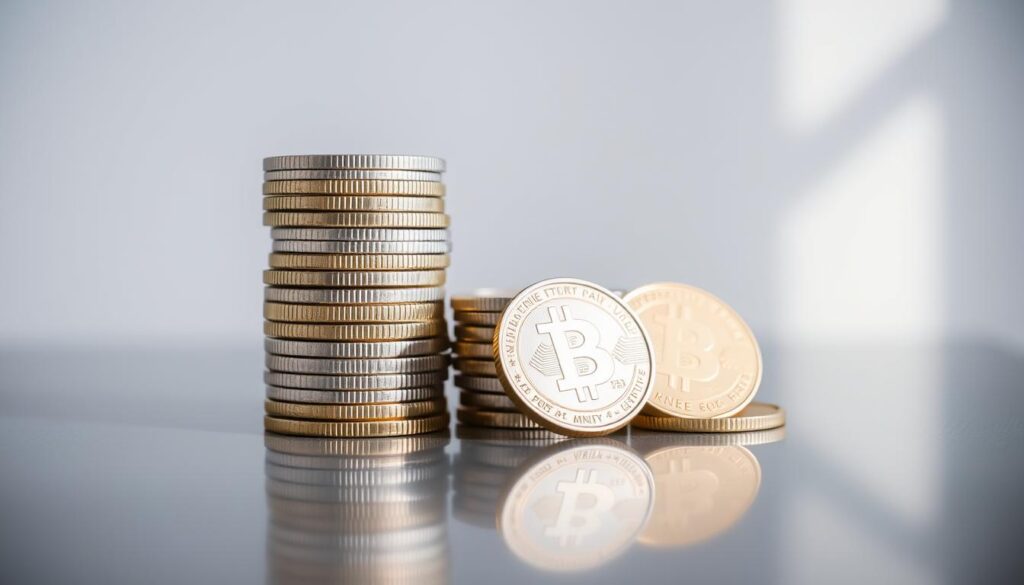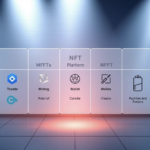Now Reading: Preparing for the 2025 Bitcoin Halving: What You Need to Know
- 01
Preparing for the 2025 Bitcoin Halving: What You Need to Know
Preparing for the 2025 Bitcoin Halving: What You Need to Know
The cryptocurrency ecosystem is bracing for a pivotal protocol update that occurs roughly every four years. While some sources reference a 2025 timeline, current blockchain data indicates the next supply reduction event will likely occur in 2028. This automated process, hardcoded into the network’s foundation, ensures predictable scarcity by cutting new coin creation by 50%.

Since the last update in April 2024 reduced mining rewards to 3.125 BTC per block, market participants have monitored the 1,017-day countdown. These programmed adjustments occur every 210,000 validated transaction blocks – a safeguard against inflation that distinguishes digital assets from traditional currencies.
Understanding this mechanism proves critical for crypto investors and technology enthusiasts alike. The upcoming change will reshape mining economics, influence asset valuations, and test network security. Our guide explores historical patterns, technical frameworks, and strategic approaches for navigating this landmark event.
Key Takeaways
- Built-in supply reduction occurs every four years through automated protocol updates
- Current projections indicate 2028 for the next major network adjustment
- Mining rewards decreased to 3.125 units per block in April 2024
- Scarcity mechanism impacts market dynamics and investment strategies
- Historical analysis reveals patterns in price movements and miner activity
- Countdown clocks track progress toward critical protocol milestones
- Staying informed helps navigate potential market volatility
Introduction to the Bitcoin Halving Phenomenon
A unique feature embedded in digital currency protocols periodically reshapes its economic landscape. This automated mechanism ensures controlled scarcity by cutting new asset creation precisely at predetermined intervals. Unlike traditional monetary systems, supply adjustments occur through mathematical rules rather than centralized decisions.
What Is the Block Reward Reduction?
The protocol slashes mining rewards by 50% after every 210,000 validated transaction groups. Each completed set takes roughly four years to process, creating predictable supply shocks. Miners currently earn 3.125 units per block, down from 6.25 before the 2024 adjustment.
Defining Moments in Cryptographic History
Four landmark events highlight this scarcity feature’s evolution:
- Genesis block creation (2009) establishing fixed supply rules
- First reward decrease (2012) validating the protocol’s functionality
- Third adjustment (2020) amid growing institutional interest
- Approaching 21 million cap with 92% already circulating
This self-regulating system contrasts sharply with government-issued currencies. By limiting new issuance through code rather than policy, the network maintains long-term value preservation.
The Evolution of Bitcoin Halving History
Digital scarcity events have consistently reshaped crypto economics since 2012. Four programmed supply shocks demonstrate how protocol rules drive long-term value creation. These milestones reveal critical patterns in network adoption and market psychology.

Early Halvings and Their Impact
The first halving took place in November 2012, slashing rewards from 50 to 25 units per block. This occurred when the network was primarily used by tech enthusiasts. Three key developments followed:
- Price surged 9,300% within a year
- Mining operations began professionalizing
- Public awareness of digital scarcity grew
Historical Trends and Timelines
The second halving occurred in July 2016, cutting rewards to 12.5 BTC. Market reactions grew more complex as institutional players entered the space. Subsequent events in 2020 and 2024 maintained the four-year rhythm, with rewards dropping to 6.25 BTC and then 3.125 BTC.
Three consistent patterns emerge across cycles:
- Price volatility increases pre-event
- Miner profitability pressures spark equipment upgrades
- Media coverage amplifies mainstream interest
As the ecosystem matures, these events increasingly influence emerging altcoin sectors. Historical data shows diminishing percentage gains post-halving, suggesting growing market efficiency over time.
Understanding Bitcoin’s Blockchain and Proof-of-Work
Every transaction in the digital currency space gets permanently recorded in an unalterable chain of data units. This decentralized system uses advanced cryptography to maintain transparency and security across a global network of participants.
How the Blockchain Secures Transactions
The blockchain operates like a digital notary. Each new group of transactions forms a block linked to previous entries through unique cryptographic signatures. This creates an immutable record – altering one block would require rewriting the entire chain.
Three security layers protect the system:
- Global network consensus for transaction validation
- Mathematical puzzles requiring significant computing power
- Automatic rejection of mismatched data across nodes
The Role of Miners in the Network
Miners act as the network’s auditors. Their specialized hardware races to solve complex equations that confirm transaction batches. Successful verification adds blocks to the chain and earns rewards in BTC.
Two key incentives drive participation:
- Fixed block rewards that decrease over time
- Transaction fees paid by users
The system automatically adjusts puzzle difficulty every 2,016 blocks. This maintains the 10-minute average block time despite fluctuations in mining activity.
Economic Implications and Crypto Market Reactions
Digital scarcity mechanics create ripple effects across financial markets. When protocol rules slash daily issuance rates, supply-demand dynamics shift. Investors watch these events closely, as reduced coin creation often sparks intense market activity.

Supply Scarcity and Price Movements
Historical patterns show striking price reactions to shrinking issuance. After the 2012 adjustment, values surged 9,900% within 12 months. The 2020 event triggered a 650% climb despite global economic uncertainty. Three factors drive these movements:
- Fixed total supply of 21 million coins
- Inelastic demand during network growth phases
- Psychological impact of programmed scarcity
Daily minting rates will soon drop from 900 to 450 coins. This supply shock could intensify if institutional adoption accelerates. Markets typically price in these changes months before protocol updates occur.
Market Trends Coinciding with Protocol Updates
Trading volumes often double in quarters surrounding major network changes. The crypto market sees increased volatility as speculators position themselves. Retail investors frequently chase momentum, while institutions deploy dollar-cost averaging strategies.
Altcoin valuations frequently mirror BTC’s price action post-event. During the 2020 cycle, Ethereum gained 480% within six months of the supply reduction. This correlation highlights Bitcoin’s role as the market bellwether for digital assets.
Bitcoin halving 2025: What Investors Should Know
Strategic portfolio positioning becomes critical as protocol-driven scarcity events approach. Savvy market participants often adjust their holdings months in advance, balancing opportunity with unpredictability.
Accumulation Strategies in Anticicipation of Supply Shocks
Three approaches dominate pre-event positioning:
- Dollar-cost averaging spreads purchases across market conditions
- Timed accumulation focuses on historical price patterns
- Portfolio rebalancing maintains target asset allocations
Retail traders often chase momentum, while institutions use algorithmic buying. Historical data shows diminishing returns: 10,000% gains after 2012 fell to 750% post-2020. This trend suggests tempered expectations for future cycles.
Navigating Market Uncertainties
Price swings typically intensify near protocol changes. Four key risks demand attention:
- Regulatory shifts affecting crypto accessibility
- Miner sell-offs impacting liquidity
- Global economic factors influencing risk appetite
- Technological advancements altering network dynamics
The understanding crypto risks becomes essential when volatility spikes. Diversification across asset classes helps mitigate exposure to sudden market moves.
Seasoned participants recommend limiting crypto allocations to 1-5% of total portfolios. This approach acknowledges the speculative nature of digital assets while allowing measured participation in potential upside.
The Miner’s Perspective: Challenges and Rewards
Network validators face evolving economic pressures as protocol updates alter reward structures. These changes test operational sustainability across different mining approaches, reshaping how participants secure transactions.

Solo Mining vs. Pool Mining Dynamics
Individual operators now compete with industrial-scale facilities housing thousands of specialized machines. Three critical challenges confront solo miners:
- Electricity costs consuming 60-80% of operational budgets
- Mining difficulty adjustments requiring constant hardware upgrades
- Diminishing block reward shares against collective processing power
Pooled operations mitigate these pressures through shared computational resources. Participants combine processing power to solve blocks, splitting rewards proportionally. While this model improves consistency, it doesn’t address fundamental profitability challenges when network payouts decrease.
Geographical factors increasingly influence operations. A recent industry analysis shows 38% of miners relocated facilities in 2024 seeking lower energy rates. This migration underscores the delicate balance between operational costs and potential earnings.
As mining rewards diminish, operators must choose between upgrading equipment or exiting the network. These decisions directly impact transaction processing speeds and overall blockchain security, creating ripple effects across the entire ecosystem.
Price Dynamics and Forecasting Future Halving Events
Market analysts scrutinize historical patterns to anticipate how programmed scarcity influences asset valuations. While past cycles show clear correlations between protocol updates and price movements, multiple external factors complicate forecasting models.
Analyzing Past Price Surges
Historical data reveals a striking trend: each supply reduction event triggers smaller percentage gains. Consider these milestones:
- 10,000% surge after 2012’s protocol update
- 2,900% climb following 2016’s adjustment
- 750% increase post-2020’s scheduled change
This pattern suggests diminishing returns, with each subsequent cycle delivering roughly 3.5x smaller gains. While intriguing, these figures don’t account for evolving market conditions like institutional adoption or regulatory shifts.
Approaches to Price Prediction Post-Halving
Analysts employ three primary methods to gauge potential outcomes:
- Technical analysis: Chart patterns from previous cycles
- On-chain metrics: Network activity and holder behavior
- Sentiment analysis: Social media and news trends
These tools face limitations as markets mature. Increased institutional participation and global economic factors now play larger roles than during early cycles. While mathematical models project a potential 200% increase for the next scheduled update, such forecasts remain speculative.
Investors should remember that protocol changes occur every 210,000 blocks – a predictable schedule that markets often price in months ahead. Diversified research and risk management prove essential when navigating these complex dynamics.
Impact on the Global Crypto Ecosystem and Community
Protocol-driven scarcity events act as catalysts for widespread innovation across digital asset networks. These moments spark renewed collaboration between developers, investors, and regulators, shaping the future of decentralized technologies.
Media Attention and Emerging Trends
Mainstream coverage amplifies awareness of crypto fundamentals during supply adjustments. Major outlets increasingly highlight the ecosystem’s self-regulating nature, contrasting it with traditional financial systems. This spotlight often coincides with surges in wallet creation and trading activity.
Three trends gained momentum after recent protocol updates:
- Community-driven educational initiatives explaining blockchain mechanics
- Accelerated development of energy-efficient transaction validation methods
- Cross-industry partnerships exploring tokenized asset solutions
The global community plays a vital role in addressing misconceptions. Grassroots efforts demystify crypto markets through webinars and open-source tools. As media attention grows, these educational resources help newcomers navigate complex concepts like proof-of-work and decentralized governance.
Emerging sectors like decentralized finance (DeFi) often benefit from renewed focus on the ecosystem. Developers leverage heightened interest to launch innovative protocols, while established projects refine their value propositions. This cycle of innovation strengthens the entire digital asset space.
FAQ
How does the block reward reduction affect miners?
When the reward drops from 6.25 BTC to 3.125 BTC in 2025, miners face lower revenue unless efficiency improves or prices rise. Many upgrade hardware or join pools like Foundry USA to stay profitable.
Why do analysts link supply scarcity to price surges?
Reduced issuance limits new coins entering circulation. Historical patterns, like the 2017 rally after the second halving, suggest increased demand against tighter supply can drive upward momentum.
What tools help investors track halving timelines?
Platforms like CoinMarketCap and Blockchain.com provide real-time block counts. The next event is expected around April 2025, based on the 210,000-block interval.
How does proof-of-work secure transactions pre-halving?
Miners validate blocks using computational power. As rewards decline, network security relies more on transaction fees, incentivizing participants to prioritize efficiency.
Which exchanges offer hedging options for volatility risks?
Platforms such as Binance Futures and Deribit let traders use futures contracts or options to manage exposure to price swings around halving events.
Can solo mining remain viable post-2025?
With rising competition and lower rewards, individual miners often join pools like AntPool or F2Pool to combine resources and share payouts more consistently.
How has media coverage influenced past halving cycles?
Outlets like CoinDesk and CNBC Crypto World amplified retail interest during 2020’s event, contributing to heightened trading volumes and speculative activity.
What metrics predict long-term price trends after halvings?
Analysts study hash rate changes, exchange reserves, and adoption rates. For example, Glassnode’s data revealed declining reserves before 2020’s bull run.













